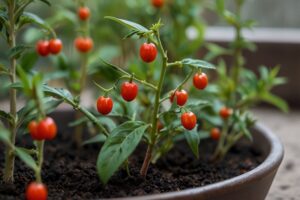Growing Goji Berries At Home: Tips From A Passionate Grower
I’m thrilled to talk about my passion, for growing goji berries with you. Being a home gardener I have found joy in nurturing these fantastic superfood berries. In this piece I’ll be sharing my advice and experiences to help you successfully cultivate your goji berries whether you have a backyard or a cozy balcony.

When it comes to growing goji berries I make sure to plant them in drained soil and provide sunlight, which is crucial for their growth. It’s essential to research pruning techniques and proper care methods as they contribute not to the plants health but also enhance berry production. Goji berries are part of the nightshade family. Are plants that adapt well to various climates making them a popular choice among gardeners.
Introducing goji berries into my garden aligns with my goal of eating. It has been a learning experience for me as I’ve educated myself on how to deal with pests and diseases that can affect goji plants. Knowing the time and method for harvesting ensures that I can savor the fruits of my labor when they are, at their freshest and most nutritious.
Why Grow Goji Berries
Goji berries are a nutrient-packed superfruit with a multitude of health benefits. Nutrient-wise, they boast high levels of antioxidants, especially notable when compared to other fruits. They offer a significant amount of vitamins A and C, alongside fiber and iron, supporting overall health and immunity.
Is it worth the effort of growing your own goji berries? It most definitely is and here is why. Goji berries are packed with nutrients, antioxidants, and health benefits. They’ve been used in traditional Chinese medicine for centuries and are now gaining popularity worldwide as a superfood. By growing your own goji berries, you can enjoy these nutritious fruits fresh from your garden!
Cultivating goji berries is easy, making them good to have in a garden of any size. They are adaptable plants, thriving in zones 3-10 and can survive in various soil types, although they prefer well-draining soil with a slightly alkaline pH. They also like lots of sun so plant in a spot where they get at least six hours of sun per day.
In the garden, goji berries serve as an attractive flair, with their small purple or white flowers providing a burst of color. When the flowers start to produce 1- to 2-inch-long scarlet fruits, my garden looks so pretty. The harvest period is generous as well; goji berries begin to ripen by mid-summer and continue until frost, providing a long harvest season.
From a culinary perspective, dried goji berries have a vast range of uses. Beyond snacking, they’re easily integrated into teas, soups, and baked goods, enhancing meals with their distinct flavor. For those inclined to be more creative, the berries can be made into homemade tinctures or even wine, lending a personal touch to my table.
Choosing the Right Location
Before I start growing the goji berries, I first look for an area with good sunlight and soil that offers good drainage and proper nutrient content. I find doing this significantly influences the growth and fruit production of the goji berry plants.
Sunlight Requirements
Goji berries require a location that receives full sun to thrive. I make sure that my garden space or containers are positioned to get at least six to eight hours of direct sunlight during the summer. The bright sun not only stimulates growth but also enhances the fruit’s flavor. If an area with all-day sunlight isn’t available, I make sure they at least get morning sun, which is less intense and can minimize stress on the plant.
Soil Conditions
The soil’s pH level is another critical factor; goji berries prefer it to be slightly alkaline, around 6.8 to 8.1. Before planting, I test my garden’s soil pH and adjust accordingly, adding amendments if necessary to achieve the ideal range. Good soil should also be rich in nutrients and well-draining to prevent root rot. I often mix in organic matter like compost to improve soil fertility and structure. If I’m using a pot, I choose one with ample drainage holes and use a mixture that facilitates aeration and moisture control.
Planting Goji Berries
The successful planting of goji berries hinges on proper initial setup, from choosing between seeds or cuttings to ensuring proper spacing and support for their growth.
Starting from Seeds or Cuttings
When starting my goji plants, I’ve found that growing from cuttings provides a head start, with more predictable results compared to seeds. It’s important to plant cuttings in well-draining soil that’s high in organic matter to bolster the root system. A mixture involving sand and compost typically creates an optimal environment for new growth. I plant the cuttings in early spring, which is ideal for them to establish before the growing season.
Spacing and Support
Once my goji berry shrub is ready for the garden, I ensure that each plant has enough space to thrive—about 3 to 5 feet apart, which allows sufficient airflow and sunlight exposure. Supporting the goji plant with a trellis or other structure is crucial as it encourages vertical growth and ease of harvest. I make sure to install trellis or stakes early so I don’t disturb the root system later. Regular watering and a layer of mulch help retain moisture and sustain the goji plants through their development. As the goji berries begin to form on my plants, sturdy support becomes increasingly significant to bear the weight of the fruit-laden branches.
Caring for Goji Berry Plants
I understand that growing goji berries requires specific attention to watering, mulching, fertilizing, and pruning practices to ensure a healthy and productive plant.
Watering and Mulching
I ensure that my goji berry plants receive sufficient water without becoming waterlogged. When watering, consistency is key; I aim to keep the soil consistently moist during the growing season, especially during dry spells. Goji berries do not tolerate overwatering well, so I make sure the soil is well-draining. I also apply a layer of mulch around the plants to retain moisture, regulate soil temperature, and prevent weed growth. Organic mulches such as straw or wood chips work well for this purpose.
Fertilizing and Pruning
I feed my goji plant with a balanced fertilizer to ensure they receive the necessary nutrients they need to grow. An application in early spring can help kickstart growth. Additionally, I incorporate compost into the soil to improve fertility and structure. When it comes to pruning, I do so to promote airflow and light penetration within the canopy. In the dormant season, I remove dead or broken branches and cut back lateral branches by about a third to encourage fruit production on the new wood. Proper care through regular pruning is essential for a plentiful goji berry harvest.
Harvesting Goji Berries
Harvesting goji berries at the right time and using proper techniques ensures the highest quality of both fresh and dried fruit. My focus is to help you identify the peak time for harvesting and to detail the most effective method for collecting these nutritious berries.
When to Harvest
Goji berries typically ripen from mid-summer to early fall, depending on your location and the variety you’re growing. The berries are ready to harvest when they turn a bright, vivid red and feel slightly soft to the touch. Unlike some other berries, goji berries don’t continue ripening after being picked, so make sure they’re fully ripe before harvesting.
How to Harvest
To harvest goji berries, simply pluck them off the branches by hand. Be gentle, as the berries are delicate and can easily be squished. If you have a large harvest, you can place a clean sheet or tarp under the plant and gently shake the branches to release the ripe berries. Collect the fallen berries and sort through them, removing any stems, leaves, or unripe fruits.
Using and Preserving Goji Berries
Goji berries, recognized for their health benefits, particularly their high levels of antioxidants, can be both a delicious and healthful addition to your diet. Understanding the best methods to consume and preserve goji berries allows you to enjoy their taste and nutrition year-round.
Fresh Eating and Recipes
I love incorporating fresh goji berries into my diet due to their sweet taste and health-promoting properties. For a quick snack, I simply rinse the berries and eat them as is, or toss them into a salad for added sweetness and color. Goji berries can also be used in various recipes, such as smoothies, salads, baked goods, and teas. If I am feeling adventurous, I create a vibrant goji berry sauce that pairs wonderfully with desserts or breakfast bowls. By blending fresh goji berries, I can also make a goji berry juice that’s rich in antioxidants.
Drying and Storing
If you have a bountiful harvest, you may want to preserve some of your goji berries for later use. The easiest way to do this is by drying them. Spread the berries in a single layer on a clean, dry surface, such as a baking sheet lined with parchment paper. Place them in a warm, well-ventilated area out of direct sunlight, and let them dry for several days until they’re shriveled and leathery. Store the dried berries in an airtight container in a cool, dark place for up to a year.
Growing goji berries is not just about the end result; it’s about the journey. Embrace the process of nurturing your plants, learning from your successes and challenges, and connecting with nature. As you watch your goji berry plants grow and thrive, you’ll find yourself growing and thriving too.
So, what are you waiting for? Start your goji berry growing adventure today and discover the joys and rewards of cultivating these incredible plants. Happy gardening!


 Previous Post
Previous Post Next Post
Next Post